Demodectic mange is caused by the demodex mite, Demodex canis, which lives in normal skin and is present in small numbers in all dogs. Humans have their own demodex mites (D. folliculorum, D. brevis) and the dog demodex mite never affects humans.
The entire life cycle of the demodex mite is spent on the skin. It lives in hair follicles and feeds on cells, serum and epidermal debris.
 Transmission of mites from bitch to puppies occurs during nursing in the first 2 days of life.
Transmission of mites from bitch to puppies occurs during nursing in the first 2 days of life.
Occasionally a puppy’s immature immune system allows the mites to multiply abnormally and mild localised skin disease results. A small proportion of affected pups have a more depressed immune system and generalised demedicosis develops.
The signs of localised demodicosis include patchy hair loss and mild scaliness on the face. Sometimes the skin is mildly red but in the early stages it is usually not itchy. Most cases occur before 6 months of age and heal spontaneously.
Up to 10% of affected dogs progress to the generalised form. It usually starts during puppyhood. With generalised demidicosis we see hair loss, inflammation and enlarged glands. Secondary bacterial infections cause scratching, redness, swelling and crusting of the skin.
Dogs with chronic generalised demodicosis have depressed immune T-cell responses. Eradication of the mites results in restoration of the T-cell function.
Breeds predisposed to generalised demodicosis include the Old English Sheep dog, Afghan Hound, Collie, German Shepherd, Staffordshire and Pit bull terrier, Doberman, Dalmatians, Great Dane, English Bulldogs, Boston terriers, Dachshunds, Chihuahua, Boxers, pugs, Sharpeis, Beagles and Pointers. Pure bred dogs have a much higher incidence than mongrels. There is evidence that it is an inherited problem.
To diagnose demodectic mange we scrape affected areas with the side of a scalpel blade and check for mites under the microscope.
We usually do not treat mild localised demidicosis as 90% of cases will clear spontaneously.
If the hair loss spreads and the skin becomes red, itchy or crusty then we treat the pup with a miticide. Regular skin scraping monitors the progress of eradication. Treatment is continued for at least a month after a negative skin-scraping.
Secondary bacterial infections are treated with antibiotics and antiseptic shampoos as they arise.


